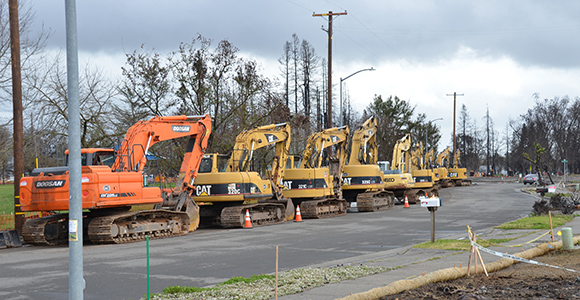
Debris removal in Santa Rosa, California after the 2017 wildfires (Photo: USACE/Mike DeRusha)
CA Fwd released a report today offering an initial assessment of the Sonoma region’s response to the 2017 wildfires and its ongoing efforts to develop a more resilient civic and governance infrastructure.
At the invitation of the City of Santa Rosa and Sonoma County, CA Fwd has been closely monitoring the recovery activities of local agencies in the North Bay, charting progress and helping local leaders respond to emerging challenges—from expanding local civic engagement to developing the fiscal and policy reforms needed for the region for meet its ambitious new housing goals.
Inspired by Sonoma’s response to the fires, resiliency has become a major theme of the 2018 California Economic Summit. CA Fwd and other partners are working to help Santa Rosa and Sonoma County develop a governing model that could be used by other regions facing similar, long-term threats from more frequent natural disasters, widening income inequality, and the rising cost of living.
CA Fwd’s assessment focuses on three areas where Sonoma has already made important progress—and highlights several issues CA Fwd believes local leaders will need to focus next. Between now and the November 15-16 Summit in Santa Rosa, CA Fwd will work with Summit partners to assist Sonoma in advancing these ideas. A detailed progress report will be presented at the Summit. (Register to attend the Summit here.)
Here are highlights from CA Fwd’s new report, charting Sonoma’s progress on three key issues:
- Governance: In the wake of the fires, the City of Santa Rosa and Sonoma County have been working to improve their governance structures, seeking to integrate a variety of agencies and policies focused on common goals (such as increasing the supply of housing) and promoting long-term resiliency strategies. This includes the creation of a new county Office of Recovery and Resiliency tasked with integrating administrative oversight of recovery activities and overseeing the implementation of priorities set by the Board of Supervisors.
CA Fwd believes the City of Santa Rosa and Sonoma County have developed the working relationship—and the governance platforms—they need to succeed. But the next step is the hardest part: integrating dozens of disparate efforts into a unified strategic plan, coordinating this activity going forward, and ensuring increasing civic engagement and community support.
- Economic recovery: Throughout 2018, city and county leaders have worked with stakeholders to develop a strategic plan for promoting economic recovery across five key areas: housing, natural resources, economic recovery, safety net services, and infrastructure.
In its new report, CA Fwd applauds Sonoma for identifying the right strategic priorities and for actively developing a new, more unified governance model through a Joint Powers Authority—formally known as the “Renewal Enterprise District” (“RED”). The city and county are focusing on areas such as housing where an integrated approach (including a modified role for the state) will be necessary to meet common goals. Now the challenge is putting needed reforms in place before year end, including creating the RED and providing it with special powers for accelerating sustainable land use decisions.
- Fiscal sustainability: As a result of emergency expenditures and declining property tax revenues, Sonoma is confronting the same challenge faced by every region recovering from disaster: long-term fiscal uncertainty and a need to reform the fiscal relationship between state and local government.
CA Fwd makes the case in its new report that the state’s current approach (backfilling lost property tax revenue on a one-time basis) is proving inadequate for long-term fiscal sustainability. In its assessment, CA Fwd encourages Sonoma to make a serious effort to push the state to adjust the allocation of the property tax from the state to local agencies in a more sustainable way—and to provide greater fiscal benefits for producing more housing.
To read the complete CA Fwd assessment, please click here.

